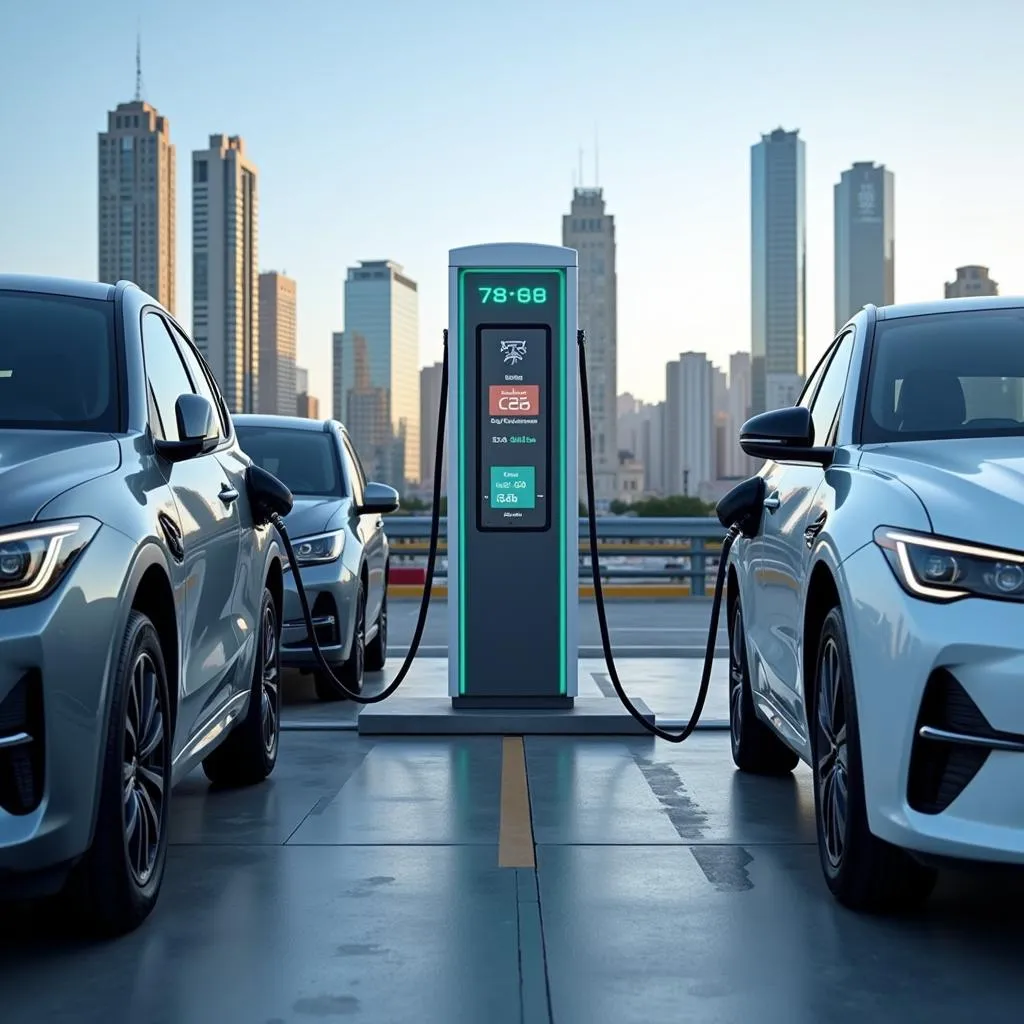Electric vehicles and their impact on transportation systems have become increasingly relevant topics in IELTS Writing Task 2. As environmental concerns grow globally, this subject is likely to appear more frequently in future exams. Let’s explore a recent IELTS question on this theme and analyze sample essays for different band scores.
Some people believe that the widespread use of electric vehicles will help solve environmental problems. To what extent do you agree or disagree with this statement?
Analyzing the Question
This question asks for your opinion on whether electric vehicles can significantly contribute to solving environmental issues. Key points to consider:
- The extent of your agreement/disagreement
- Environmental problems that electric vehicles might address
- Potential limitations or drawbacks of electric vehicles
- Other factors that may influence environmental solutions
Sample Essay 1 (Band 8-9)
The increasing adoption of electric vehicles (EVs) has been hailed by many as a potential solution to numerous environmental challenges. While I largely agree that EVs can play a significant role in addressing certain environmental issues, I believe their impact may be limited without concurrent changes in other sectors.
Electric vehicles undoubtedly offer several environmental benefits compared to traditional combustion engine vehicles. Firstly, they produce zero direct emissions, which can substantially reduce air pollution in urban areas, leading to improved public health outcomes. Secondly, as electricity grids increasingly transition to renewable energy sources, the overall carbon footprint of EVs will continue to decrease, contributing to the mitigation of climate change. Moreover, the quieter operation of electric vehicles can help reduce noise pollution in cities, enhancing the quality of life for residents.
However, it is crucial to recognize that electric vehicles alone cannot solve all environmental problems. The production of EVs, particularly their batteries, still requires significant resources and energy, which can have environmental impacts. Additionally, the electricity used to power these vehicles must come from clean sources to maximize their environmental benefits. Without a concurrent shift towards renewable energy in the power generation sector, the positive impact of EVs may be limited.
Furthermore, other environmental issues such as deforestation, water pollution, and biodiversity loss require separate, targeted solutions beyond the scope of transportation. While electric vehicles can contribute to reducing air pollution and greenhouse gas emissions, they do not directly address these other critical environmental challenges.
In conclusion, while I strongly believe that the widespread adoption of electric vehicles can significantly contribute to solving certain environmental problems, particularly those related to air quality and carbon emissions, it is not a panacea for all environmental issues. A holistic approach, combining clean transportation with sustainable practices across all sectors, is necessary to truly address the complex environmental challenges we face today.
(Word count: 309)
Sample Essay 2 (Band 6-7)
In recent years, electric vehicles have become more popular as a way to help the environment. I agree to some extent that electric cars can help solve environmental problems, but I also think there are some limitations.
One of the main advantages of electric vehicles is that they don’t produce emissions when driving. This means they can help reduce air pollution in cities, which is a big problem in many places. Electric cars are also quieter than normal cars, so they can reduce noise pollution. As more people use electric vehicles, it could lead to cleaner air and less health problems caused by pollution.
However, there are some drawbacks to consider. The production of electric cars, especially their batteries, can still harm the environment. Mining the materials for batteries can damage ecosystems. Also, if the electricity used to charge these cars comes from coal or other dirty sources, it doesn’t fully solve the problem of pollution.
Another issue is that electric vehicles are still expensive for many people. This means that not everyone can afford to switch to an electric car, which limits their impact on the environment. There’s also the problem of charging infrastructure, which needs to be improved in many countries.
While electric vehicles can help with some environmental issues, they can’t solve all of them. Problems like deforestation, plastic pollution in oceans, and loss of wildlife habitats need different solutions. Electric cars mainly help with air pollution and reducing greenhouse gases, but other environmental problems require separate actions.
In conclusion, I believe that electric vehicles can contribute to solving some environmental problems, especially related to air quality in cities. However, they are not a complete solution to all environmental issues. We need to combine the use of electric vehicles with other environmentally friendly practices to really make a difference.
(Word count: 295)
Explanation of Band Scores
Band 8-9 Essay:
This essay demonstrates several qualities of a high-scoring response:
- Clear position with a nuanced perspective
- Well-developed ideas with specific examples
- Cohesive structure with clear paragraphing
- Wide range of vocabulary used accurately
- Complex sentence structures
- Addresses all parts of the question thoroughly
Band 6-7 Essay:
This essay shows characteristics of a mid-range score:
- Clear overall position
- Relevant main ideas, though less fully developed
- Adequate organization, though less sophisticated
- Good vocabulary, but less precise than the Band 8-9 essay
- Mix of simple and complex sentences
- Addresses the main parts of the question
The key differences lie in the depth of analysis, sophistication of language, and overall coherence of the arguments presented.
Key Vocabulary
-
Mitigation (noun) /ˌmɪtɪˈɡeɪʃn/: The action of reducing the severity or seriousness of something.
-
Panacea (noun) /ˌpænəˈsiːə/: A solution or remedy for all difficulties or diseases.
-
Holistic (adjective) /həʊˈlɪstɪk/: Characterized by the belief that the parts of something are interconnected and can be explained only by reference to the whole.
-
Concurrent (adjective) /kənˈkʌrənt/: Existing, happening, or done at the same time.
-
Infrastructure (noun) /ˈɪnfrəstrʌktʃə(r)/: The basic physical and organizational structures and facilities needed for the operation of a society or enterprise.
-
Ecosystem (noun) /ˈiːkəʊsɪstəm/: A biological community of interacting organisms and their physical environment.
-
Biodiversity (noun) /ˌbaɪəʊdaɪˈvɜːsəti/: The variety of plant and animal life in the world or in a particular habitat.
-
Emissions (noun) /ɪˈmɪʃn/: The production and discharge of something, especially gas or radiation.
 Electric vehicles at a charging station
Electric vehicles at a charging station
Conclusion
The topic of electric vehicles and their impact on environmental issues is likely to remain relevant in IELTS Writing Task 2. To prepare effectively, practice writing essays on related themes such as:
- The role of government in promoting electric vehicle adoption
- Comparing public transportation and electric vehicles as environmental solutions
- The economic impact of transitioning to electric vehicles
Remember, the key to success in IELTS Writing Task 2 is not just about knowledge of the topic, but also about how well you can structure your arguments, use a range of vocabulary, and address all parts of the question.
We encourage you to practice writing your own essay on this topic and share it in the comments section below. This active practice is an excellent way to improve your writing skills and prepare for the IELTS exam.
How climate science is reshaping global policies is another important topic that often intersects with discussions on electric vehicles and environmental solutions. Understanding these interconnections can help you develop more comprehensive and insightful essays for your IELTS Writing Task 2.


